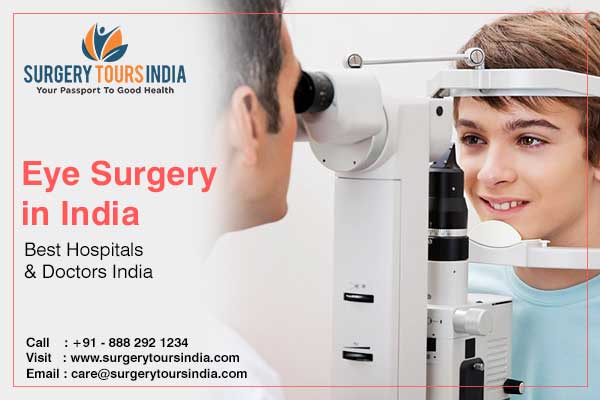
An eye surgery is one of the most intricate and delicate surgical procedures. It might be performed to treat an eye disease and to correct or improve vision in the affected eye. These types of surgeries require the expertise of an experienced eye surgeon or an ophthalmologist as the eye is one of the most delicate and sensitive vital organ of the body.
Eye surgeries employ various techniques and approaches depending on the disorder or the location of the deformity in the eye region.
An eye surgery may be performed using conventional open-type surgery or a minimally invasive surgery technique as well. Nowadays the use of laser technology in eye surgery is gaining quite a popular demand.
There are a number of different eye surgical procedures and the methods of performing these surgeries are also varied.
These are a few commonly performed eye surgeries along with their procedure techniques:
Laser Eye surgery
Laser eye surgical techniques use a fine beam of high-frequency laser light to perform delicate surgeries in the eye. Lasers can be used to treat refractive and non-refractive eye conditions. A corneal laser surgery uses a beam of laser to re-contour the surface of the eye. This procedure is used to treat short-sightedness (myopia), far-sightedness (hypermetropia) as well as distortion in the eye's curvature (astigmatism).
This is the preferred option for surgery technique in case the patient wishes to avoid using eyeglasses to improve the vision in the eyes.
Cataract surgery
A cataract causes the crystalline eye lens to get cloudy or opaque. Cataract is often caused by aging, trauma or an eye disease and prevents the light from outside in making a clear image at the back of the eyeball on the retina. In case the condition gets severe as to result in loss of vision in the affected eye it might be required to surgically remove the optical lens and replace it with an artificial intra-ocular lens (IOL).
Due to the high number of cataract cases this type of surgery is one of the most common eye surgeries in the world.
Glaucoma surgery
Glaucoma consists of a number of diseases that affect the optic nerve in the eye, resulting in loss of vision caused due to a raised intra-ocular pressure (IOP). There are a number of different glaucoma surgeries that are either performed singularly, or in combination with others to allow the excessive aqueous humor (eye fluid) to drain from the accumulated area and lower the pressure on the optic nerve.
Canaloplasty
This is a minimally invasive surgical procedure used to drain the excessive aqueous humor from the eye's natural drainage system in order to relieve the intra-ocular pressure (IOP) from the optic nerve. This surgery is performed using a micro-catheter which is inserted into the canal of the eye through a very tiny incision. The micro-catheter helps enlarge the main drainage channel and the connecting smaller channels by injecting a sterile and gel-like substance known as a 'visco-elastic'. This surgery helps in reducing pressure from the optic nerve by draining excess fluid from around the optic nerve through enlarging the natural drainage system of the eye.
Refractive surgery
This is a group of eye surgeries that aim to correct deformities of the refraction of the eye by reducing or preventing the need for artificial lenses.
These are a few refractive surgeries:
Corneal surgery
A corneal surgery is used to correct abnormalities and disorders of the cornea through various different techniques and methods.
A corneal surgery includes most of the refractive surgical procedures as well as a few others, such as:
Vitreo-retinal surgery
These types of surgery are used to mainly treat disorders affecting the retina in the eye.
These are some common vitreo-retinal surgeries:
Eye Muscle Surgery
This surgery is used to correct the condition where a person's both eyes are unable to align normally to focus on a fixed point. It is also known as 'heterotropia'.
There are specific procedures for treating different muscle groups, such as:
Oculoplastic surgery
This is a plastic procedure used to reform the eye and its related structure. These involve surgical treatments for droop eyelids, repairing tear duct obstructions and orbital fractures as well as removal of eye tumors. The oculoplastics procedures also involve surgical treatments such as laser skin resurfacing, brow lifts, eye lifts and face lifts.
You are considered a candidate for any type of eye surgery if:
Delhi has a vast network of ophthalmic clinics and hospitals that have the latest and most modern treatment and surgical equipments. These hospitals and clinics specialize in care and treatment of any type of eye disorder or eye injury with global-quality hospitality standards. Delhi has a calm and comforting environment that makes your visit all the more comfortable.
As with any major type of surgery there might be a risk of certain complications arising in rare cases. These risks may develop as a result of an anomaly in the eye structure or due to an underlying condition.
These are certain risks seen after a laser eye surgery:
There are certain risk factors that may arise after a cataract-related eye surgery, such as:
Surgery Tours India Medical Tourism Consultants are well known for their experience in arranging and managing a medical tour for eye surgery in India at the best and most affordable cost. Surgery Tours India is connected with the most modern and efficient ophthalmic hospitals and clinics that have well-experienced ophthalmologists as well as eye surgeons.
For more information please contact us at
Email: [email protected]
Phone: +91-888 292 1234 / +91-9730 001 540